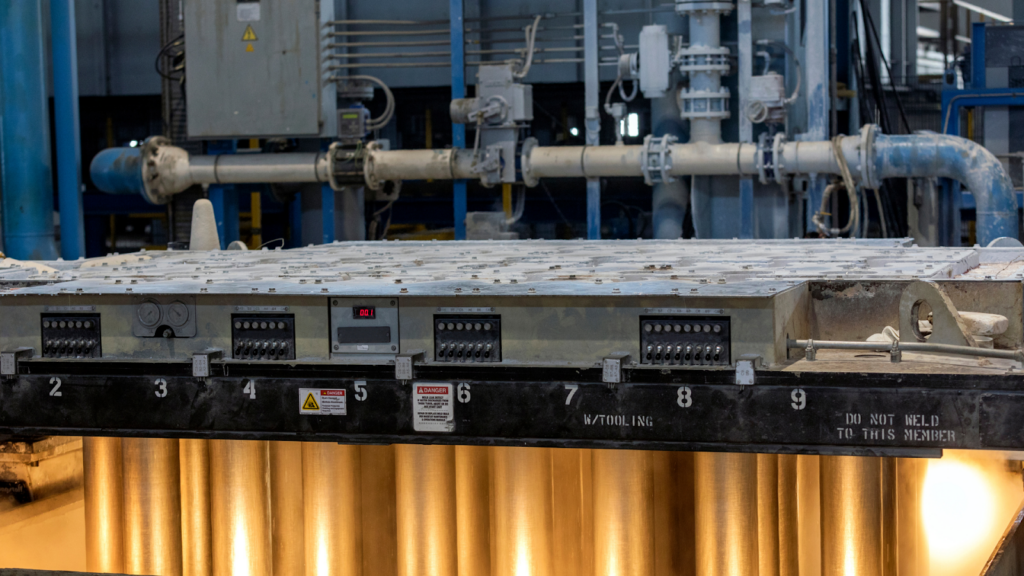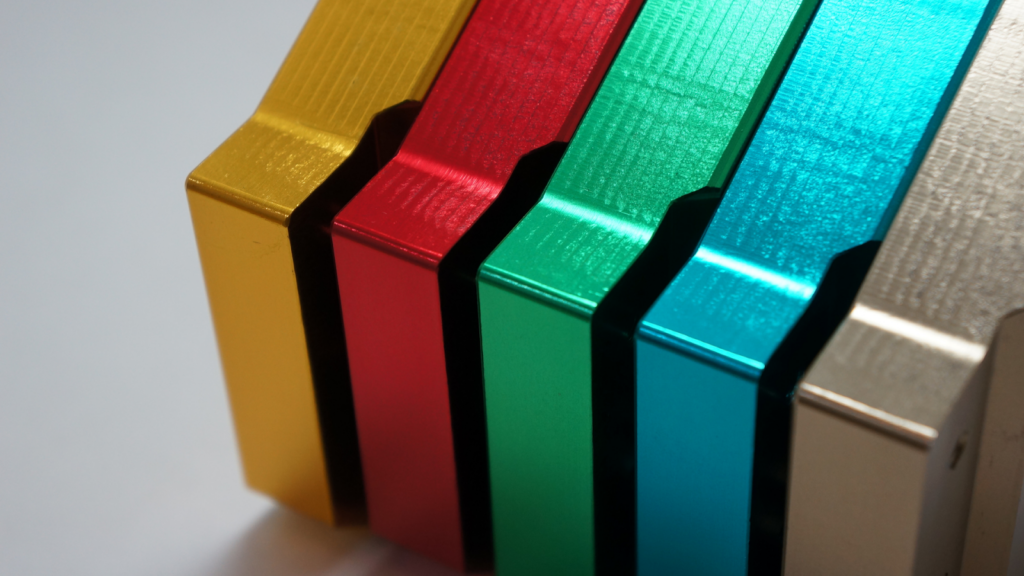Aluminum, the second most widely used metal in the world,(1) offers a multitude of applications across various industries. One important technique employed to enhance the properties and appearance of aluminum is anodizing. This process involves the formation of a durable oxide layer on the surface of aluminum, creating a protective barrier and allowing for customization through color and texture.
In this guide, we’ll explore the types, benefits, and processes of anodizing aluminum. We’ll also discuss the differences between anodizing and electroplating, as well as the common factors to consider when using anodized aluminum. Finally, we’ll answer some frequently asked questions about anodizing aluminum to help you gain a comprehensive understanding of this versatile metal finishing technique.
Looking to get your aluminum components anodized? Request a free quote or contact us today for a comprehensive assessment of your anodizing needs and a personalized solution tailored to your requirements!
What Is Anodized Aluminum?
Anodized aluminum is aluminum that has undergone an anodizing process to create a durable and protective oxide layer on its surface. This process involves immersing the aluminum in an electrolyte bath and applying an electrical current, which stimulates the formation of an oxide coating.
The resulting anodized aluminum possesses enhanced corrosion resistance, increased hardness, and improved aesthetic appeal. It also provides the metal with better resistance to wear, abrasion, and fading.
Anodized aluminum is widely used in various industries, including aviation, defense, medical/life sciences, and space and communication systems, due to its excellent properties and versatility.
How Does Anodizing Work?
Anodizing is an electrochemical process used to increase the thickness of the oxide layer on the surface of aluminum components.(2) The process involves immersing the aluminum in a chemical solution and passing an electric current through it. This causes the aluminum to oxidize, creating a protective layer impermeable to water and other corrosive elements.
The process starts with preparing the aluminum component. This involves cleaning and degreasing the surface and then etching it to create a uniform surface.
The component is then placed in an electrolytic bath filled with an acid solution, and an electrical current is applied. The current causes the aluminum to oxidize, forming an oxide layer on the surface.
Once anodized, the aluminum component is removed from the bath and rinsed with water to remove any remaining chemicals. It is then sealed using a sealing solution. The sealing process helps to protect the component from corrosion and further wear and tear.
What Are The Benefits Of Using Anodized Aluminum?
The benefits of using anodized aluminum are numerous. Let’s explore some of these benefits in more detail:
Durability
Anodized aluminum is known for its exceptional durability. The anodization process creates a protective layer on the surface of the aluminum, making it highly resistant to corrosion, scratches, and wear. This durability ensures that anodized aluminum products have a longer lifespan and can withstand harsh environmental conditions, making them ideal for various applications.
Corrosion Resistance
Corrosion resistance is a significant benefit of using anodized aluminum. The anodized coating acts as a barrier, preventing the aluminum from coming into direct contact with corrosive elements such as moisture and chemicals. This resistance to corrosion extends the lifespan of anodized aluminum products and makes them suitable for use in outdoor or corrosive environments without the risk of degradation.
Aesthetic Appeal
Depending on the type of anodizing process used, anodized aluminum can offer a wide range of aesthetic options. The anodization process allows various colors and finishes to be applied to the aluminum surface, enhancing its appearance and providing a decorative element. This makes anodized aluminum a popular choice for architectural projects, consumer products, and automotive components, where visual appeal is important.
Costs
Cost-effectiveness is another advantage of using anodized aluminum. While the anodization process adds a protective layer to the aluminum, it is still a relatively inexpensive surface treatment compared to other options. Additionally, the enhanced durability and corrosion resistance of anodized aluminum reduces maintenance and replacement costs over time. This makes anodized aluminum a cost-effective choice for various industries and applications.
Types Of Anodized Aluminum
There are several types of anodized aluminum, each offering specific benefits. The most common types include:
Type I Anodized Aluminum
Type I anodized aluminum, also known as chromic acid anodizing, is a basic form of anodization that provides a thin (up to 0.0001 inches) and porous oxide layer on the aluminum surface. This type of anodizing offers minimal corrosion resistance but improves adhesion for subsequent paint or adhesive applications.
Type II Anodized Aluminum
Also known as sulfuric acid anodizing, Type II anodized aluminum is the most commonly used type of anodization. It creates a thicker oxide layer (0.0002 to 0.001 inches) than Type I, providing better corrosion resistance and durability.
Type II anodized aluminum can also be dyed to achieve various colors and finishes, offering greater aesthetic options.
Type III Anodized Aluminum
Type III anodized aluminum, also called hard coat anodizing or sulfuric acid anodizing with a higher voltage, produces a thicker and more durable oxide layer (above 0.001 inches).
This type of anodization significantly enhances the corrosion resistance, wear resistance, and hardness of the aluminum surface, making it suitable for applications that require maximum durability. It is commonly used in aerospace, defense, and industrial sectors where extreme conditions and high-performance requirements are present.
Additionally, Type III anodizing can also be dyed to achieve different colors and finishes, providing both functionality and aesthetic appeal.
Want to get started with any of these anodizing processes? Reach out to us today for professional anodizing services tailored to your specific needs!
The Anodizing Process Of Aluminum
The anodizing process of aluminum involves several steps:
- The aluminum part is cleaned to remove any dirt, grease, or oxide layers.
- It is immersed in an electrolyte solution, typically containing sulfuric acid, and acts as the anode in an electrical circuit.
- A direct current is passed through the circuit, causing oxygen ions from the electrolyte to react with the aluminum surface, forming an oxide layer.
- After anodization, the aluminum part is rinsed and sealed to enhance the corrosion resistance and durability of the oxide layer.
- The final step may involve dyeing the anodized surface if desired, providing color and aesthetic options.
Difference Between Anodizing And Electroplating?
Anodizing and electroplating are two distinct surface treatment processes used to enhance the properties of metal objects.
Anodizing involves creating an oxide layer on the surface of a metal, typically aluminum, through an electrochemical process. This oxide layer provides improved corrosion resistance and can be further enhanced with colored dyes.
On the other hand, electroplating involves depositing a thin layer of metal onto the surface of a metal object, typically through an electrolytic process.(3) Electroplating is primarily used to enhance the appearance of objects, provide a protective coating, or improve conductivity.
While anodizing focuses on creating an oxide layer, electroplating involves depositing a layer of metal, making them distinct processes with different applications.
Disadvantages Of Anodizing Aluminum
Anodizing aluminum has many advantages, but there are also some disadvantages to consider.
One of the main drawbacks is the fact that anodizing requires a specialized process that is costly and time-consuming.
Additionally, the process of anodizing aluminum can be complicated and requires high expertise. The process also requires a large amount of energy, which can increase the cost of production.
Furthermore, anodizing can produce undesirable byproducts, such as chromic acid, which can be hazardous if not handled properly.
Common Factors To Consider When Using Anodized Aluminum
When using anodized aluminum, there are several common factors to consider:
- It is important to take into account the durability of the anodized coating
While anodizing enhances the corrosion resistance of aluminum, the thickness of the coating can vary, affecting its overall durability.
- The color options for anodized aluminum are limited compared to other surface finishes
The range of available colors is typically limited to metallic tones, which may not suit all design preferences. Additionally, anodized coatings can be susceptible to scratching and wear over time, so proper care and maintenance are necessary to preserve their appearance.
- The dimensional changes that occur during the anodizing process should be considered for precise applications, as the coating can slightly increase the dimensions of the aluminum parts.
If You’re Looking For An Efficient And Cost-Effective Way To Protect Your Aluminum Components, Consider Anodizing!
Anodizing offers a highly efficient and cost-effective solution for protecting aluminum components. By forming a durable oxide layer on the surface, anodizing enhances the material’s corrosion resistance and durability. This process also provides opportunities for customization, as various colors and finishes can be achieved.
With its ability to improve both the aesthetics and functionality of aluminum parts, anodizing stands as a compelling choice for those seeking optimal protection and longevity.
Make anodizing part of your aluminum component protection strategy and enjoy the numerous benefits it brings.
For high-quality anodizing services, check out Valence today! We offer a wide range of professional anodizing services tailored to meet your specific needs. Our experienced team utilizes advanced techniques and state-of-the-art equipment to ensure exceptional results. Whether you require anodizing for aviation, defense, medical/life sciences, and space applications, we have the expertise to deliver superior protection and a stunning finish.
So don’t compromise on the quality and longevity of your aluminum components – request a free quote or reach out to us today for a comprehensive assessment of your anodizing needs!
Want to learn more about anodizing processes? Check out:
- Anodizing Aluminum For Aerospace Applications: A Comprehensive Guide
- Anodizing Types: A Comprehensive Comparison Of Type II Vs. Type III Anodizing
FAQs
Is anodizing better than powder coating?
Anodizing is generally considered to be more durable and corrosion-resistant than powder coating. It also offers a greater range of color options, as well as the ability to customize the color of the finish.
What type of process is anodizing?
Anodizing is an electrochemical process that changes the surface of the aluminum to create a protective, corrosion-resistant layer. The process involves immersing the aluminum in an acid bath and then applying an electric current to create an oxide layer on the surface of the metal.
Does anodized aluminum rust?
Anodized aluminum is highly resistant to corrosion and rust and is often used in applications where corrosion resistance is a priority.
What is the best alloy for anodizing?
The best alloy for anodizing is typically one that has a high aluminum content, such as 6061 or 7075.
What are two uses of anodizing?
Anodizing is often used to improve the durability and corrosion resistance of aluminum components, as well as enhance their aesthetic appeal.
Sources:
- Aluminium: The metal of choice – researchgate. (n.d.-a). https://www.researchgate.net/publication/293653225_Aluminium_The_metal_of_choice
- Anodizing. Anodizing – an overview | ScienceDirect Topics. (n.d.-a). https://www.sciencedirect.com/topics/chemistry/anodizing#:~:text=Anodizing%20is%20an%20electrochemical%20process,resistant%2C%20hard%20and%20abrasion%20resistant.
- Electroplating. Electroplating – an overview | ScienceDirect Topics. (n.d.). https://www.sciencedirect.com/topics/physics-and-astronomy/electroplating.

